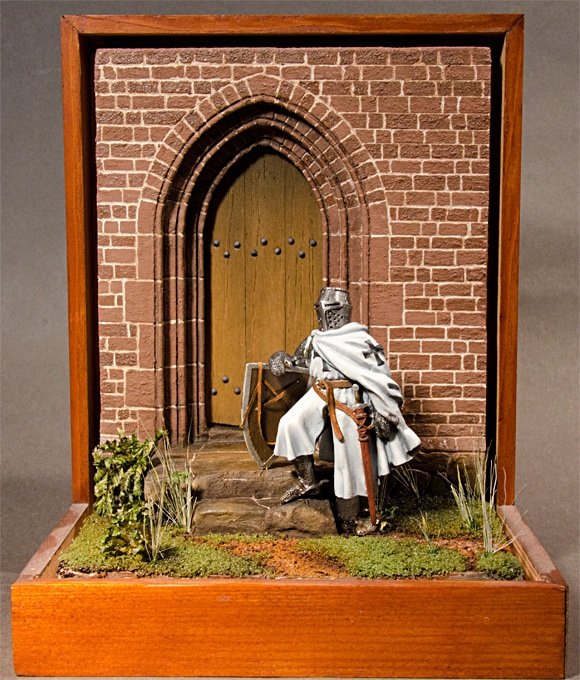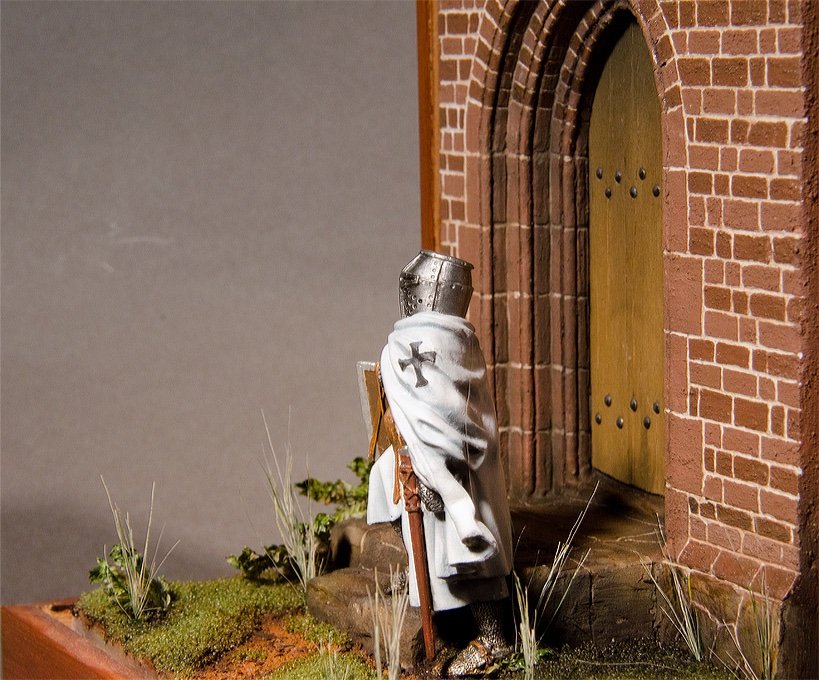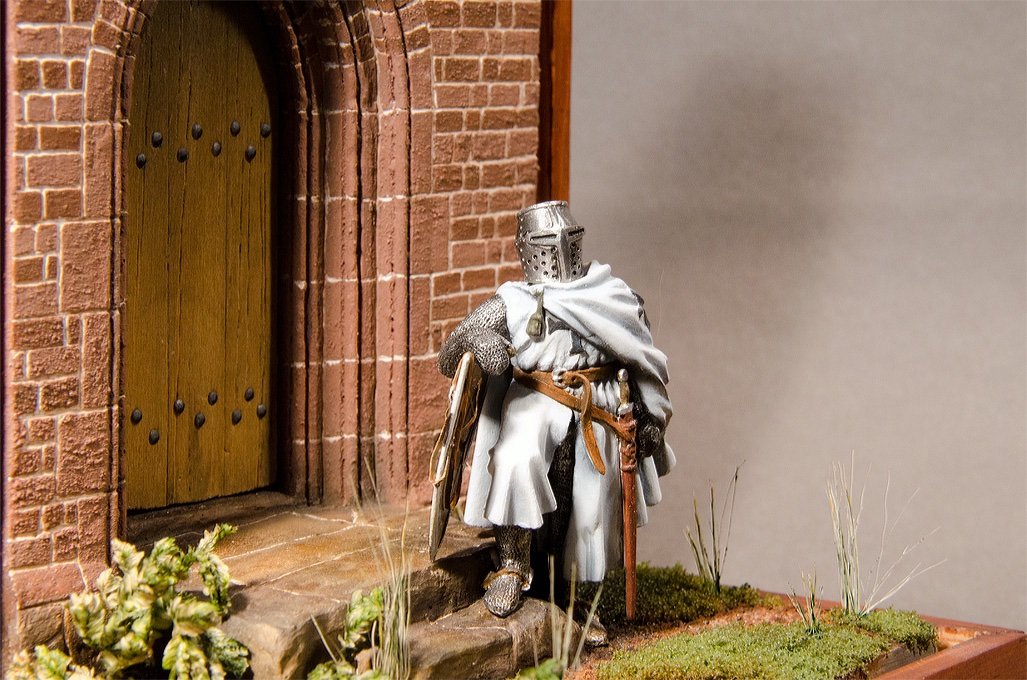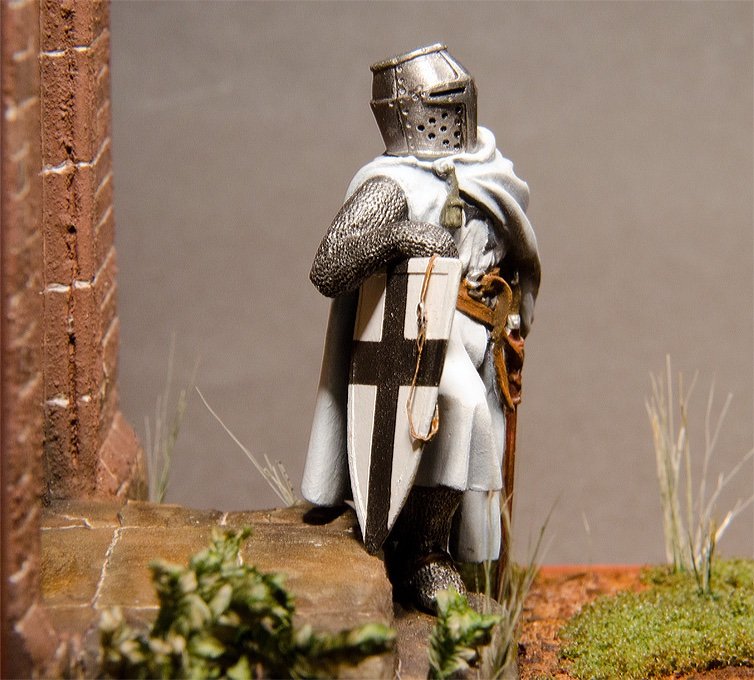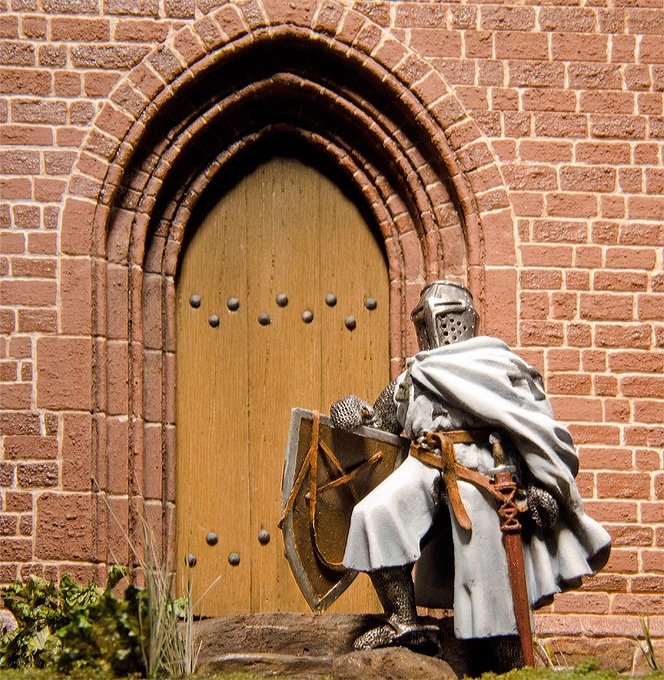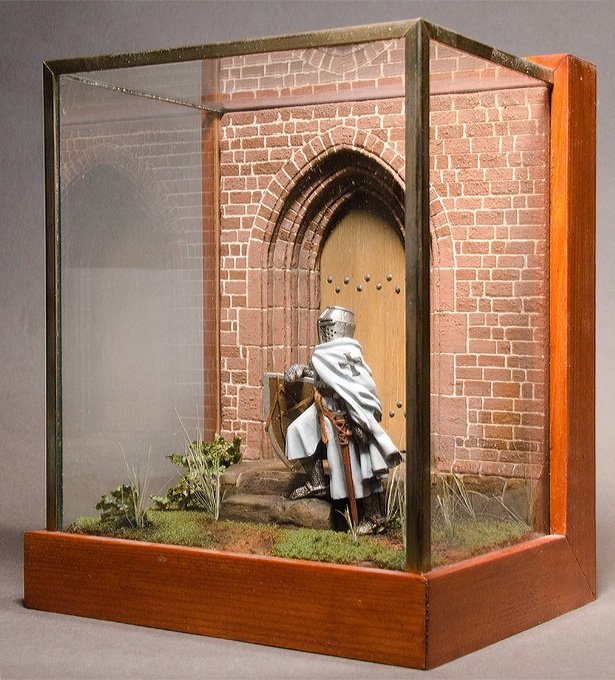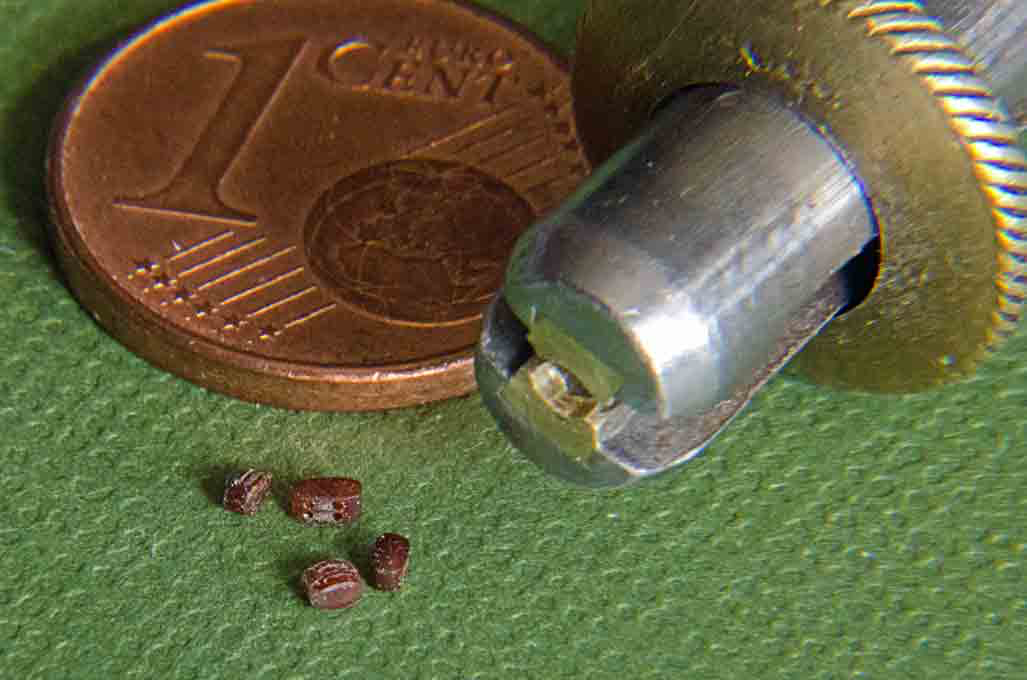-
Posts
6,459 -
Joined
-
Last visited
Content Type
Profiles
Forums
Gallery
Events
Everything posted by wefalck
-
I build this in the early 1990s on the basis of a kit by Friulmodel (https://friulmodel.hu/termek/mp-5-knight-hospitaller-c-1150/). The helmet was still good for around 1200, but the shield had to be changed to the more modern, rounded triangular form of the time. The chain-mail and helmet is the bare white-metal, polished, while the coat was painted with the airbrush in acrylics. Details were added with a brush in acrylics and oil. The background is modelled after the Chorin-monastery not far from Berlin. The bricks and stonework are shaped and engraved from plaster of Paris and painted.
-

Rigging of a the 5 masted bark named France II
wefalck replied to Icarus24's topic in Masting, rigging and sails
Incidentally, this appears to be a sailor's model and when I interpret the jumble on the second picture correctly, the model was rigged as a 5-masted ship, not barque. There seems to be also an anachronism, as on the model the shrouds are rigged with dead-eyes, but at that time bottle-screws would have been used. For all ships French I would turn to the Association des Amis du Musée de la Marine in Paris (https://www.aamm.fr). They are usually helpful and also have English-speakers. Arguably the best source on early 20th rigging of steel ships is this (albeit in German): MIDDENDORF, F.L. (1903): Bemastung und Takelung der Schiffe.- 401 p., Kassel (reprint 1977 by Horst Hamecher). The Author was responsible for the design of inter alia PREUSSEN. -
It would be difficult to know what materials and techniques the Vickers-Armstrong model-workshop used, if the model was actually made in-house and not contracted out to professional modell-building workshop. However, I would first consult textbooks on paints and paintfinished published around that time. They give recipes, list raw materials and application techniques. Raw materials at these times often went by 'common' names and 'trivial' names for chemical compounds that sometimes are not so easy to identify today. However, there are encyclpedias/dictionaries that explain these to the interested public or the commercial people of the time. Such books can be now downloaded from the Internet in many cases. I am not so acquainted with the English-language literature on this subject, so I cannot point to specific works. This is a time, when people began to experiment more frequently with man-made materials ('plastics' in the widest sense) and this can occur as construction materials and as binders in paints as well. However, these 'plastics' were not normally derived from mineral oil, but rather from organic raw materials. Celluloid and bakelite come to mind, as examples, but there are also casein-based raw materials. The post WWI period also has seen an increasing use of synthetic dyes and pigments in addition to the traditional mineral and organic ones. There is also an abundant literature on conservation and restoration issues and techniques, either in the form of textbooks or scientific articles in journals or as contributions to symposia etc. Certain individuals or museums have specialised in particular aspects, such as metal or wood conservation, or paint restoration. Obviously, the big maritime and technical museums around the world face the same problems and might be prepared to provide advice or can at least direct you to the right sources of information.
-
According to my German 1878 textbook on (naval) boatbuilding, the diagonal planking was up to 30% lighter, than a carvel-planked boat and even more so for a lap-strake built one. However, building costs were higher and they are also more difficult to repair. The diagonal-carvel system (as in this example) was used particularly, when the hull was to be (partially) varnished on the outside, rather than painted all over. A tropical hardwood was preferred for the inner planking to better resist rotting - it would have been very difficult to replace inner planking without essentially dismantling half of the boat. The model is coming on nicely. It's a pity that not much of the inner diagonal strakes will be visible at the end.
-

Proper blade for 2mm acrylic rod
wefalck replied to modella's topic in Modeling tools and Workshop Equipment
The original manufacturers of acrylic glass (Plexiglas) recommend using water as a lubricant. However, with such thin rod it is not really needed. Just use the finest piercing saw blade you can get and don't work too fast. Scoring and snapping-off is also a procedure recommended by the manufacturers. Works for rods and sheets up to about 3 mm thickness. -

What glue are these instructions calling for?
wefalck replied to rooster's topic in Modeling tools and Workshop Equipment
Got this kit in 1977, but dumped almost everything except for the hull. The hull (and the awfull deck) are vacuum-formed styrene, if I remember correctly, so if you keep the deck, the two parts should cement together with the usual styrene cement. If the parts are ABS, you would use a standard 'contact' cement, the kind that you apply to one side, let it almost dry and then bring the two parts together. You don't say, where you are based, so there is probably no point referring to any brand of cement. As I said, I dumped the deck-part at that time and made a new deck from a sheet of ABS that was carefully fitted to the inside of the hull. It was cemented in place with some little wooden blocks that were cemented into the hull first. All glueing was done with contact cement. I 'planked' the deck with paper-backed self-adhesive wood-veneer. The deck-houses and hatches were built up from sheets of ABS also covered in this kind of wood veneer. Not sure, whether I would do this again, but it lasted very well until today. I then glued bullwark stanchions to the inside of the hull. With the hull stabilised like this, I half-filled it with Plaster of Paris to give weight, trimmed off the horizontal part of vacuum-formed hull and added a wooden capping rail. Incidentally, this was my first model that was built from scratch except for the hull, because I just wasn't happy with what the kit provided. -
Dumont indeed is one of the brands to go to. I have a small arsenal of watchmakers tweezers and also various biological ones that I inherited from my father. He had also a very good dentist one, but that got lost in a house move unfortunately. Tweezers is one thing I would hesitate buying on-line. One really need to see how well they close. Good quality ones then will last for ever, if not mistreated or dropped to the floor. I've been using my favourite one for over 30 years on a daily basis. BTW, don't junk your cheapo ones, use them, when you have to hold hot stuff, e.g. during soldering, as this my draw the temper from your good ones and you don't want to do that ...
-
Actually, the 'tarred' bilge looks very convincing ... the rest is coming on nicely too.
-
I litterally spent the last six months trying to solve exactly this problem. For my current project I need only 1.6 mm and 2.0 mm long double outside iron-strapped blocks in a shape appropriate for the later 19th century, but I meant to develop a procedure with which I can make larger number of reasonably uniform blocks down to 1 mm length. There were originally two main criteria: a) avoid drilling numerous tiny holes down to 0.1 mm diameter and b) ensure that the rope runs out tangentially from the block and doesn't stick out radially with a sharp kink. Many years ago it occurred to me that one could etch the shells and sheaves from brass sheet (using surface etching) as parts that can be folded up and then soldered together. Unfortunately, at the moment I am not set up for etching anymore, so this idea was not practical. Since I bought a small laser-cutter about two and a half years ago, I attemped to adapt the above idea and cut the pieces from Canson-paper. Cutting the parts as such went well, but the precise alignment of the tiny flecks of paper proved impossible and the holes for the rope tended to fill up with the lacquer I used for laminating. Being paper (albeit soaked in lacquer) the blocks could not really be sanded - particularly holding them for the purpose was just not feasible. After numerous attempts with different configurations for building the blocks from layers I gave up. I also attempted a variant of the above using brass sheaves and making only the shell from paper. However, turning 0.6 mm brass sheaves of 0.2 mm or less thickness did not work even on my watchmakers lathe, at least not in quantities. I tried the method of building up layers from styrene sheet and using brass sheaves. While styrene sands better than paper, the problems of holding and making the sheaves remain. For an earlier model I had tried to mill and drill blocks from brass or perspex rod. Perspex is easy to machine, but thin parts are very brittle. Brass can be machined to intricate shapes, but drilling multiple 0.2 mm holes into brass is a challenge and may result in many broken drills ... In the end I reverted back to a miniaturisation of the traditional method of shaping blocks in a row from strips sawn to the outside dimension. However, I am not using wood, because the grain, even in boxwood, causes problems at these small dimensions. I prefer to use brown bakelite as used in electronics and electrical applications. Bakelite can be a bit brittle, but machines and polishes well. The procedure I finally arrived at is (based on the capacity of my micro-milling vice, I working with batches of eight blocks) for a 1.5 mm block: 1- Cut strips that are a tad wider than the blocks are long from bakelite sheet of suitable thickness (here 1 mm) 2 - Mount strips into the milling vice so that 0.15 mm deep grooves for the sheaves can cut with a 0.2 mm circular saw blade 3- Repeat from the other side 4- Re-orient the milling vice so that at one end, in suitable distance from the edge, 0.2 mm holes can be drilled through the grooves 5- Re-position the strip, so that the grooves for the strap can be milled into the top- and bottom-ends with a conical burr 6- Rough-shape the block by milling off the corners with the same conical burr 7- Take the strip back to the circular saw and cut off the individual blocks 8- Hold the block in a pin-vice that has a recession milled in and round-off with a rubberised abrasive wheel in the hand-held drill 9- Round-off the groove into the drill-hole using a tiny graver fashioned from a piece of 0.2 mm thick piercing saw blade (for holes above 0.25 mm diameter also diamond-studded piercing saws wires are available that can be used for this) The blocks are now ready for the external strap. I tried the strapping with flattened copper-wire, but this proofed to be too flimsy and broke all the time. In the end I used the round wire, although this is not quite correct - there are limitations. Basically, I loope the wire around the block and then drilled the two ends together. For blocks that have an eye at one end, the eye was first formed with very fine tweezers and the wire then looped around the block as before. The block was held in the same adapted pin-vice as above. A collection of blocks and the special pin-vice to hold them This is how far I got. The next step will be forming the hooks and stiffening them with solder. Otherwise the wire is too soft. Earlier stages of these tries are illustrated in my current building log:
-
Very clean work, as usual. Are these doors stamped or soldered together from two layers ?
-
No. The yoke was used when rowing and under sail. Locking the rudder would make it rather hard to steer the boat with the oars and it is very tiring for the rowers, when they constantly have to adjust the speed or force to make small corrections of the course. This is done by one or two 'helmsmen' at the rudder pendants according to the commands by the NCO or officer in charge of the boat.
- 433 replies
-
- open boat
- small boat
-
(and 1 more)
Tagged with:
-
On the yoke vs. tiller: I had a look in my old textbooks on naval boats, but there they state that cutters may use a yoke for steering and it is not very wide. I gather, when being rowed, sharper turns can be achieved by rowing on one side only, while under sail, the driver placed far aft, yawl-fashion would aid the steering by either hauling it more or less taught, so changing the tendency of the boat going into the wind or otherwise. Thus the rudder would only be needed for small corrections of the course.
- 433 replies
-
- open boat
- small boat
-
(and 1 more)
Tagged with:
-
Nice work on the flags. And I agree that printing on thin paper is probably more successful. I usually then repaint with acrylics, as the the printer inks may not be very lightfast. Also liked the 'engineering' approach to the grapnels. Not so simple to recreate these simple fire-welded units. The flags made me curious, as they have as the main motive the colours of Aragon (the red and yellow stripes), which also appears in the flags and coats-of-arms of Catalonia, Barcelona, Valencia, Spain in general, and various others. Its a long story dating back to the Counts/Kings of Aragon, who sort of spread to the coastal zone of Eastern Spain and SE France as the Reconquista progressed. A bit of the history and the flags can be read here in German/English: https://www.flaggenlexikon.de/ffrkprov_dt.htm. It appears that your flag was created only in 1999 for the then newly created 'region' of Provençe-Cote-d'Azur (the French administration assembled a number of the Départements created after the French Revolution into larger units of certain economic and cultural coherence over the past 20 years or so, to some degree re-establishing the ancient feudal-political units that the revolution intended to break up).
- 41 replies
-
To my knowledge Lees reviewed the literature and the models of the time. With models of the time it is always an uncertainty, if and when they might have been re-rigged or 'restored', of course. However, these are the best guesses we have. Books that cover a too wide range in time and geography are always problematic, because they will lack in depth and thoroughness - due to the limited knowledge of the authors and constraints imposed by the publishers (who are only interested in what sells, not what might be useful for a small group of afficionados).
-
The question may be a bit too late, but weren't the oars not to have a metal band around the blade to prevent splitting ?
- 433 replies
-
- open boat
- small boat
-
(and 1 more)
Tagged with:
-
According to my 1878 textbook on naval (and other boats), the cutters in the Imperial German Navy, which were modelled after those of the RN according to a statement in this book, had a yawl-rig with lug-sails and a short running bow-sprit, very similar to the drawing David showed earlier. The driver-mast was bracketed to the transom. Gigs and smaller boats had a single lug-sail. I have no information on Italian naval boats, but it seems that they were quite similar all around the world at that time.
- 433 replies
-
- open boat
- small boat
-
(and 1 more)
Tagged with:
-
It is quite possible that buckets were used and that the seat of ease contained a bucket, rather than opening to the outside. Sometimes small vessels had in later years small deckhouses at the forward bulwark one both sides (one may have been the paint-locker) with a half round roof. That's for 'serious' business, otherwise you just pee over the lee-rails or into the gutter ...
-
I was about to make the same comment as 'Beef Wellington', the barrels are way to small for the carriages or vice versa. In order to determine which one might be right for your ship (what is 'LN' ?), you could have a look what kind of guns she would have carried and then check against contemporary sources how big the guns would have been. Another possibility to check is to measure the hight of the bearings for the trunnions above the deck - this should be more or less at the middle of the gun ports so that the muzzle would be in the middle of the gun port (as was pointed out by someone already), when the barrel is elevated to the horizontal. Hopefully, one of them is the correct size. Then it would be a good idea to make either the barrels or the carriage from scratch. There are lots of ideas how to do this on this forum.
-
Imitating expensive woods (or marble) has been very much en vogue until the 1920s or and still seems to enjoy a certain tradition in some countries. Some 30 years ago I picked up this instruction manual: Hemming, C. (1985): Paint Finishes.- 144 p., London (Macdonald & Co.). that describes in detail how to do 'wood-graining', 'marbelling' and other techniques and what tools and materials to use.
- 433 replies
-
- open boat
- small boat
-
(and 1 more)
Tagged with:
About us
Modelshipworld - Advancing Ship Modeling through Research
SSL Secured
Your security is important for us so this Website is SSL-Secured
NRG Mailing Address
Nautical Research Guild
237 South Lincoln Street
Westmont IL, 60559-1917
Model Ship World ® and the MSW logo are Registered Trademarks, and belong to the Nautical Research Guild (United States Patent and Trademark Office: No. 6,929,264 & No. 6,929,274, registered Dec. 20, 2022)
Helpful Links
About the NRG
If you enjoy building ship models that are historically accurate as well as beautiful, then The Nautical Research Guild (NRG) is just right for you.
The Guild is a non-profit educational organization whose mission is to “Advance Ship Modeling Through Research”. We provide support to our members in their efforts to raise the quality of their model ships.
The Nautical Research Guild has published our world-renowned quarterly magazine, The Nautical Research Journal, since 1955. The pages of the Journal are full of articles by accomplished ship modelers who show you how they create those exquisite details on their models, and by maritime historians who show you the correct details to build. The Journal is available in both print and digital editions. Go to the NRG web site (www.thenrg.org) to download a complimentary digital copy of the Journal. The NRG also publishes plan sets, books and compilations of back issues of the Journal and the former Ships in Scale and Model Ship Builder magazines.


